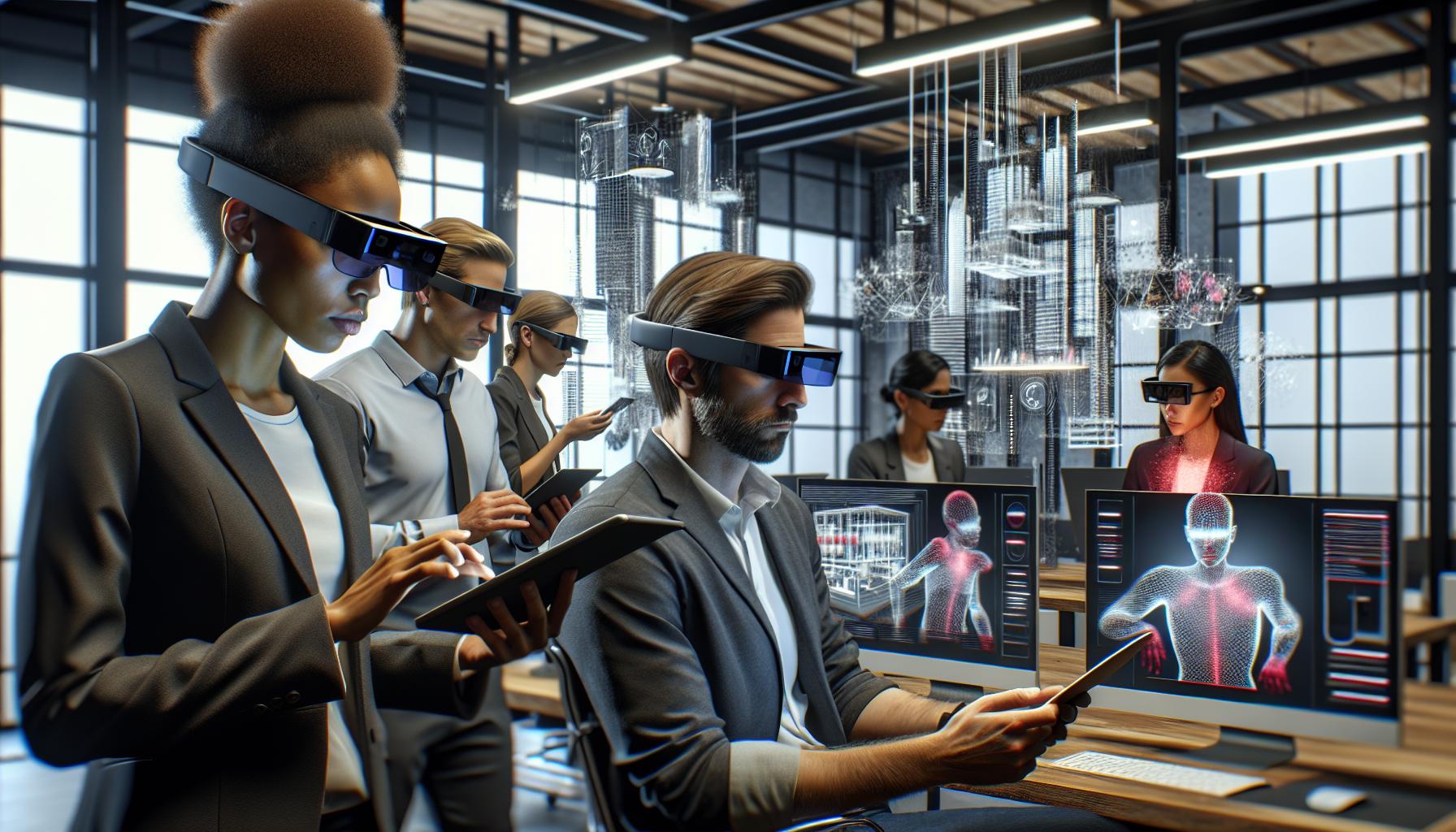In a world where reality sometimes feels a little too mundane, augmented reality services companies are here to spice things up. They’re the wizards behind the curtain, transforming everyday experiences into captivating adventures. Imagine walking down the street and suddenly spotting a virtual dinosaur doing the cha-cha next to you. Sounds wild, right? That’s the magic of augmented reality.
Augmented Reality Services Companies
Augmented reality services companies play a crucial role in merging the physical world with digital enhancements. They develop solutions that overlay computer-generated content on real-world environments, enriching user interactions. Businesses across various sectors utilize these services to improve customer engagement and brand recognition.
Technology integration forms a significant part of these services. Companies provide tools like AR software development kits (SDKs) for application creation. They also offer custom solutions tailored to specific industry needs. Enhancements in visualization tools streamline complex data interpretations and facilitate informed decisions.
Some industries benefit greatly from augmented reality. Retailers utilize AR for virtual try-ons, allowing customers to visualize products before purchase. In healthcare, training simulations improve skills without risk, creating a safe learning environment. Real estate agents provide virtual property tours, increasing potential buyers’ confidence without visiting physically.
Key players in the market include established firms and startups. Leaders like Niantic and PTC set industry standards with innovative applications. Smaller companies often introduce fresh ideas and agile solutions, driving rapid advancements in technology.
Services provided by these companies encompass consulting, development, and maintenance. They assist organizations in implementing AR technologies efficiently. Continuous support ensures clients maximize their investment while adopting cutting-edge strategies.
Collaboration also plays a significant role in AR development. Partnerships between AR companies and various sectors foster creativity and broaden application scopes. By working together, firms can create immersive experiences that captivate users and encourage brand loyalty.
Key Players In The Industry

Several companies dominate the augmented reality services landscape. Each organization contributes unique expertise and solutions to enhance user experiences.
Company Profiles
Niantic leads with its well-known AR games, creating engaging outdoor experiences that encourage physical activity. PTC excels in providing AR solutions for manufacturing, enabling real-time project visualization. Snap Inc. makes significant strides in social media by integrating AR lenses for users. Microsoft, through its HoloLens, delivers enterprise-focused AR solutions that enhance collaboration. Innovative startups like 8th Wall drive advancements in web-based AR, expanding accessibility. Significant players partner with various sectors to develop tailored applications that resonate with users.
Market Positioning
Market positioning for these companies varies based on their core offerings. Niantic focuses primarily on entertainment and social interaction, capturing a broad audience. PTC emphasizes industrial applications, catering to enterprises looking to optimize operations. Snap Inc. targets younger demographics with its social media features, while Microsoft positions itself in the corporate sector to drive productivity. Innovative startups, like 8th Wall, disrupt traditional models with flexible web solutions that require minimal hardware. Together, these players shape the augmented reality market, establishing unique positions that enhance industry dynamics and foster technological innovation.
Types Of Augmented Reality Services

Various augmented reality services support the development and implementation of innovative AR solutions. Companies offer specialized services to meet diverse client needs, ensuring optimal integration of AR technologies across industries.
Custom Development
Custom development focuses on creating tailored AR applications that align with specific business goals. Companies assess client requirements and design unique solutions that enhance user experiences. Examples include interactive training modules for healthcare or brand experiences in retail. By using advanced AR software development kits, firms build functionalities that resonate with target audiences. Each app integrates seamlessly into existing systems, promoting smoother user interactions.
Integration Services
Integration services facilitate the embedding of augmented reality technologies into existing workflows. Specialists work with businesses to ensure compatibility between AR solutions and current software platforms. Effective integration optimizes operational processes while enhancing user engagement. Companies support various industries such as automotive and real estate, where precise AR implementations improve overall functionality. Seamless connectivity allows for a more coherent experience, fostering better customer interactions.
Consulting Services
Consulting services provide expert guidance on effectively adopting augmented reality technologies. Experienced consultants assess current business models and suggest AR strategies that maximize impact. They analyze industry trends and identify opportunities for growth through AR integration. This strategic advice empowers companies to make informed decisions and allocate resources efficiently. Tailored recommendations ensure organizations remain competitive in a rapidly evolving landscape.
Benefits Of Augmented Reality Services

Augmented reality services deliver several significant advantages that enhance organizational performance and user interaction.
Enhanced User Experience
Engagement with augmented reality creates interactive experiences. Users benefit from immersive content that makes products more relatable. Retailers can implement virtual try-ons, allowing customers to see how products look before purchasing. In real estate, virtual property tours help potential buyers visualize living spaces without an in-person visit. Enhanced storytelling through AR captivates audiences, driving customer interest and brand loyalty. Providing unique experiences helps businesses stand out in competitive markets, fostering stronger customer connections.
Increased Efficiency
Implementing augmented reality significantly boosts efficiency across industries. Training simulations in healthcare, for example, allow professionals to practice procedures in risk-free environments. Employees can familiarize themselves with equipment through AR overlays that provide real-time data and instructions. Reducing training time leads to quicker onboarding processes and improved productivity. Integration of AR into workflows minimizes error rates by delivering precise guidance, enhancing overall operational efficiency. Organizations realize cost savings from streamlined processes and improved decision-making capabilities.
Challenges Faced By Augmented Reality Services Companies
Augmented reality services companies encounter several challenges that impact their operations and market presence. These challenges stem from various factors, including technology limitations and competitive dynamics.
Technological Barriers
Technological barriers pose significant hurdles for augmented reality services companies. Developing high-quality AR experiences requires sophisticated hardware and software capabilities, which can be costly. Limited access to powerful devices hampers user engagement, particularly among those using older mobile technology. Additionally, integration with existing systems becomes complex, demanding specialized expertise. Companies often struggle with ensuring compatibility across different platforms and devices, adding to the development timeline. Security also represents a concern, as protecting user data in AR applications necessitates robust measures against potential breaches.
Market Competition
Market competition in the augmented reality landscape intensifies constantly. Established players like Niantic and PTC dominate with their unique offerings, leveraging significant brand recognition. Startups emerge rapidly, driving innovation and pushing market boundaries, which escalates rivalry. Companies must differentiate themselves through unique value propositions to attract clients. Furthermore, price competition can impact profit margins, necessitating strategic pricing models. Success requires keeping abreast of emerging trends and technologies, ensuring companies remain relevant amid fluctuating consumer preferences. Establishing strategic partnerships can enhance visibility and market reach, providing a competitive edge in this dynamic environment.
Future Trends In Augmented Reality
Augmented reality is evolving rapidly, with innovations transforming various sectors. Enhanced interactivity is one key focus. Companies are introducing more engaging experiences, particularly in retail and education. For instance, virtual try-ons and immersive training modules provide users with hands-on, practical applications.
Development of AR glasses represents another significant trend. Industry leaders are investing in lightweight and affordable options. These devices aim to make AR more accessible for everyday users. Meanwhile, advancements in AR cloud technology allow for persistent experiences across different devices. This capability enhances collaboration and social interaction in virtual environments.
Integration of AI with augmented reality is also on the rise. Intelligent algorithms personalize user experiences based on behavior and preferences. Integration enhances engagement and retention, making applications feel more intuitive. Gamification within AR is gaining traction as well, inviting users to participate in challenges and rewards that promote engagement.
Cross-industry collaboration is shaping the future landscape of augmented reality. Partnerships between tech giants and traditional industries foster innovation. For example, automotive companies leverage AR for maintenance training and showroom experiences. Real estate services utilize AR for virtual property tours, streamlining the purchasing process for potential buyers.
Sustainability considerations are increasingly influencing AR development. Organizations strive to create eco-friendly solutions that minimize resource consumption. Businesses leverage AR to reduce waste, especially during prototyping and design phases. These trends underscore the commitment of augmented reality services companies to enhance user experiences while contributing positively to society.

